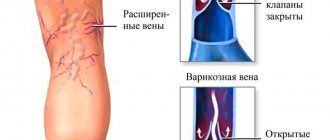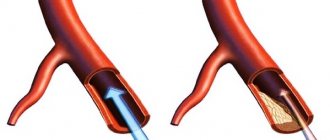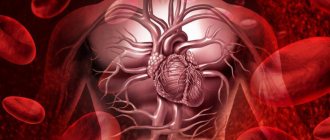A modern person, who spends most of his free time on his feet, knows firsthand about such troubles as impaired blood supply to the extremities, nagging pain, varicose veins, etc. All these problems are in one way or another related to the work of blood vessels - veins and arteries - which are dealt with by a special branch of clinical medicine called angiology. Accordingly, the main character of today's article is a vascular surgeon. We will try to find out in detail who it is and what it treats.
Doctors are different: what does a vascular surgeon do?
The goal of the professional activity of a vascular surgeon (angiosurgeon) is to select an intervention that will not require large incisions if surgery is necessary. This can happen for a variety of reasons, because the blood vessels of the human body are very vulnerable. In different areas they can swell, activating pathological processes and subsequently causing serious complications, ranging from impressive cosmetic defects to the formation of painful trophic ulcers.
Taking into account the fact that the vessels are located throughout the body, it is impossible to say with exact certainty the presence of plaques or whether they are present in a specific place. But this is temporary until the tumor grows to such a size that it begins to interfere with normal blood supply. Therefore, the vascular surgeon:
- diagnoses pathologies of the great vessels;
- treats lesions that develop as a result of household or mechanical trauma;
- detects oncological processes, for example, when the tumor is close to an artery or vein;
- provides treatment related to vascular prosthetics and removal of congenital pathologies;
- practically implements diagnostics, surgery and conservative therapy, and also takes relevant preventive measures aimed at minimizing complications.
The doctor’s competence also includes microplastic surgery, which is relevant in cases where traumatic surfaces cannot be closed using traditional methods, as well as when it is necessary to “sew on” fragments of amputated limbs to restore their functions.
Principles of therapy by an angiosurgeon
Not everyone can answer the question of what exactly a vascular surgeon does. A doctor of this profile performs the following tasks:
- diagnosis of any pathologies associated with blood vessels and the lymphatic system of the human body;
- restoration of the integrity of traumatically damaged veins and arteries;
- the fight against cancer that affects blood vessels, grows in them or is dangerously close to them;
- prosthetics of damaged vessels;
- elimination of congenital vascular anomalies, for example, hemangiomas or malformations;
- microsurgical operations that are performed to restore the integrity of blood vessels and other tissues during traumatic amputation of limbs or their parts;
- carrying out conservative therapy for diseases of the vascular system;
- development and implementation of methods for the prevention of pathologies of their profile (as well as methods that prevent the development of complications of the disease and stop its progression).
In addition, an angiosurgeon and vascular surgeon is a specialist who develops new surgical treatment methods
vascular lesions. He conducts research, studying new pathologies and the atypical course of old diseases, finding out the prerequisites for their occurrence and methods of therapy.
Consultation with a vascular surgeon: for what diseases is it necessary?
Nowadays, vascular pathologies have become significantly younger, and their congenital forms have become more frequent, so there are many reasons to consult a specialist. These include tumors of various locations, and congenital arteriovenous pathologies with all the ensuing negative consequences: pain, dysfunction of organs and systems, etc.
One of the most common reasons for turning to angiosurgeons is a disease such as atherosclerosis, which until recently was exclusively the province of the elderly, and today is called the “plague of the 20th century.” This disease is characterized by the deposition of cholesterol plaques in the lumen of blood vessels, which can lead to their narrowing in diameter. As a result, normal blood flow is significantly disrupted.
In addition to atherosclerosis, a vascular surgeon deals with:
- Diseases of the arteries - inflammation, narrowing, expansion.
- Problems with veins - varicose veins, phlebitis, thrombophlebitis, thrombosis, trophic ulcers.
- Hypertension, strokes, heart attacks, vegetative-vascular dystonia, aortic aneurysms, coronary heart disease.
- Vascular damage, embolism of arteries and veins.
- Damage to the vessels responsible for the blood supply to the brain.
When a patient approaches, the specialist’s first priority is to assess all the factors causing the suspected disease, regardless of the stage of its development. A professional in his field should conduct an angiological study, which will determine the cause of the vascular pathology that has arisen and help make an accurate diagnosis. Depending on it, the optimal tactics for organizing the treatment process are selected. In most cases, the treatment of such ailments is combined, implying not only drug treatment, but also sclerotherapy techniques, as well as compression treatment. The positive result is also supported by physiotherapeutic techniques.
If the disease is very advanced and its rapid progression is observed, the doctor may resort to surgical treatment methods.
Prognosis and prevention
With early treatment and prevention of complications, the prognosis is favorable. Vascular pathologies today are successfully treated with conservative and surgical methods, while maintaining the patient’s high quality of life.
Vascular diseases are best prevented by using medications that lower cholesterol levels, as well as products that contain polyunsaturated fatty acids that can prevent the development of atherosclerosis. It is recommended to adhere to the principles of a healthy diet, do not consume fatty and fried foods, and alcohol. It is advisable to quit smoking and start exercising to strengthen the heart muscle and prevent the development of many diseases, including obesity and hypertension. Moderate physical activity has a positive effect on the entire cardiovascular system.
After 30-35 years, check your cholesterol levels and monitor your blood pressure numbers. If symptoms of vascular disorders appear, begin treatment promptly before complete damage to the arteries and veins occurs.
Consultations with a doctor online Taking care of your health is a life priority for everyone.
Communicate with doctors online and receive qualified assistance without leaving your home. Try it Please note! The information on this page is provided for informational purposes only. To prescribe treatment, you must consult a doctor.
Visiting a vascular surgeon: when and under what circumstances?
In the question of what a vascular surgeon treats, an important aspect is a clear understanding of when it is necessary to act, that is, go to see a doctor, without letting your condition take its course. Ideally, consultation with this specialist should be part of mandatory annual preventive measures. There are also certain symptoms that indicate that medical attention is necessary. These are such special cases as:
- frequent headaches that have no specific cause (ARVI, colds, chronic diseases);
- a feeling of heaviness in the lower extremities, as if they were “cast iron” and a “humming” burning sensation in the feet and calves;
- feeling of noise in the ears and head;
- the flight of “flies” before the eyes;
- tingling, numbness, coldness in the limbs and other areas of the body;
- varicose veins;
- discomfort and pain while walking and hiking, especially in the feet, fatigue;
- pulsation in the abdominal area;
- frequent swelling of the lower extremities, which is accompanied by the appearance of compactions and redness;
- hemorrhages and non-healing wounds;
- spider veins;
- convulsions that are not dependent on physical activity;
- loss of sensation;
- prolonged discomfort from the chest, side, lumbar region (can extend to the buttocks, groin and legs);
- change in the color of the fingers (from bluish to almost black);
- loss of coordination, loss of consciousness, falling.
Competence of a cardiac surgeon
Usually, a person is referred to a cardiac surgeon when an ordinary cardiologist has lost hope of helping the patient with medications or some other relatively safe measures. In this situation, there is an urgent need to treat the victim surgically in a short time.
But even after receiving an appointment with a cardiac surgeon, this does not always mean that the patient will undergo surgery.
First, the doctor will have to carefully examine your medical history and also request many additional tests. In very rare cases, a professional may even advise leaving everything as it is, since the risks of death for the patient are several times greater than the chances of successful treatment. Sometimes there is not even a minimum percentage of success, which is typical for advanced stages of the disease.
The pediatric cardiac surgeon deserves special attention. He often has to work even with babies. Babies may have a congenital heart defect. This depends on the heredity of the parents, as well as their bad habits, which adversely affected the baby during the mother’s pregnancy.
Numerous experiments have proven that smoking, alcohol abuse and other harmful habits such as poor nutrition of parents are the basis for heart problems in the heirs. Moreover, this also applies to fathers, and not just mothers, since the same smoking fathers will transmit distorted information through genes. It is not for nothing that a cardiological consultation always begins with a small questionnaire regarding the presence of addictions and possible genetic predisposition.
Prescribing tests, diagnostics
In order to objectively assess the current state of the blood vessels and make a clear diagnosis, a specialist needs the results of a laboratory test of blood parameters. This is, first of all:
- clinical, biochemical blood test, especially a number of indicators that are related to cholesterol - its level, fat, high and low density indicators. Depending on the result of the clinical analysis, the condition of the vascular walls, the level of erythrocytes and leukocytes, hemoglobin, and the atherogenicity coefficient are determined.
- clotting test;
- platelet activity indicator.
In particular cases, you may also need a general urine test, determination of antibodies in the blood serum, fibrinogen level, etc.
Further diagnosis is carried out on the basis of examination of the patient, ECG data, as well as special additional studies. These include:
- ultrasound duplex scanning of blood vessels;
- Doppler ultrasound, which allows you to objectively assess the functional state of the main arteries and peripheral circulation, including the state of arterial blood flow in the legs;
- angiography, which determines the exact location of the narrowing or blockage of the vessel;
- X-ray examination of cerebral vessels;
- MRI, CT and similar studies.
Research will depend on what kind of disease needs to be cured. In some cases, additional consultation with related specialists who work according to the principles of their own diagnostics may be required. But in any case, this stage of treatment is approached with the utmost care, because not only the state of health, but also a person’s life may depend on the correctness of the diagnosis.
Is stroke associated with vascular disease? Tell us about the mechanisms of its development.
Stroke is one of the main causes of mortality and disability both in our country and abroad. In Russia, 450 thousand people develop stroke annually, a third of them die in the acute period of the disease, 80% of survivors have motor and speech disorders
In the United States, more than 600,000 strokes occur per year and more than 200,000 brachiocephalic artery surgeries are performed to prevent or recur ischemic strokes. In Russia, these statistics are even more depressing - 450,000 strokes and only about 10 thousand operations on the BCA. Mortality from ischemic stroke among men aged 35 to 74 years is 9 times higher, among women 10 times higher than in France.
Indeed, in most cases, a stroke or acute cerebrovascular accident develops with severe atherosclerosis of the arteries supplying blood to the brain. The main suppliers of blood to the brain are the carotid arteries. Atherosclerotic narrowing or blockage of the carotid arteries leads to temporary or permanent brain damage by cutting off part of the brain from the blood supply. The risk of developing a stroke increases as atherosclerosis progresses, the atherosclerotic plaque grows and its “instability” forms, that is, a condition when there is a danger of ulcer formation, destruction of the internal lining of the artery and on the surface of the damaged vessel the risk of thrombosis increases significantly. When a blood clot or part of an atherosclerotic plaque breaks off, it travels through the carotid arteries into the brain and blocks the flow of blood to a certain area of the brain. Depending on the size of the particle and where it ultimately ends up, the patient develops a transient (minor stroke or transient ischemic attack) or permanent cerebrovascular accident (stroke).
Classic signs of a cerebrovascular accident include: loss of vision in one eye, difficulty speaking, numbness, weakness or paralysis of one side of the body or face, and problems with balance or coordination. If these symptoms of cerebral vascular damage occur, or you want to undergo a preventive examination, contact our center for a consultation with a vascular surgeon. A thorough examination of the condition of the carotid arteries using ultrasound methods (primarily duplex scanning) allows us to answer the question of what measures need to be taken to prevent a stroke or its recurrence.
With severe atherosclerotic narrowing of the carotid arteries, the main measure to prevent stroke is the elimination of atherosclerotic plaques that impede normal blood circulation to the brain, which can only be achieved surgically. In this case, an operation known for more than 50 years is performed, such as carotid endarterectomy. This operation, first performed in 1953 by the outstanding American vascular surgeon Michael DeBakey, is well established in the leading vascular clinics of the world, provides a long-term positive result, and carries minimal risk in most patients. The stay in the clinic is usually 24-48 hours. Most patients experience minor discomfort for a short time and are able to return to normal activities after treatment within 7-14 days.
As an alternative to surgical treatment, an intravascular (endovascular) technique is used, which is balloon angioplasty with stenting. Currently, international studies are evaluating the effectiveness of this technique for the treatment of carotid artery atherosclerosis. This procedure is performed in conjunction with angiography under local anesthesia through a puncture in the groin. The essence of the procedure is the intravascular placement of a special catheter with a balloon to the site of narrowing of the carotid artery. When the balloon is inflated in the lumen of the carotid artery, the narrowed area is widened. To consolidate the effect, stenting of the dilated carotid artery is performed by installing an internal stent (frame) of the vessel. The recovery period after angioplasty with stenting is also 1-2 days.
What is the difference between a vascular and cardiovascular surgeon?
Cardiovascular surgery is a special branch of medicine in which surgical interventions are performed on the heart and large blood vessels, such as the aorta, pulmonary trunk, etc. of varying degrees of difficulty. Within the framework of this medical profile, various operations are performed on the heart or large vessels, if it is not possible to eliminate severe forms of their diseases using conservative methods. Most often, cardiovascular surgeons perform operations to treat ailments such as coronary heart disease, arrhythmia and heart failure. In addition, defects and tumors of the heart, aorta or pulmonary trunk (both congenital and acquired) are successfully eliminated. In this case, the causes of the disease do not play any role, because during the surgical intervention, normal physiology is restored, which improves the functioning of the organ, improves the patient’s quality of life and has a positive impact on his life expectancy.
When to make an appointment
Typically, the professor will accept the patient only after he first visits the general practitioner and receives a referral from him to a regular cardiologist at the clinic. The latter, not seeing any opportunity to help the victim, will send him further - to his colleague with operational methods of intervention.
You should sound the alarm after detecting at least several of the following signs:
- pain in the sternum;
- weakly palpable, but increased pulse;
- shortness of breath even with minor physical exertion;
- constant lethargy, which is sometimes replaced by irritability or sadness;
- unstable heartbeats;
- premature aging ahead of biological age;
- rapid fatigue even for no apparent reason.
It is worth highlighting separately the problems that plague a person with constant low blood pressure. This disease is called hypotension and is characterized by two characteristic signs: pale skin and facial swelling.
But if the applicant has a pronounced red-blue tint of the skin on the cheeks, then this indicates a functional deviation of the mitral valve.
There are also typical symptoms of regularly high blood pressure. Such victims have a bumpy nose, which almost always retains a reddish color. Also, veins are clearly visible on the nose, which are slightly protruding blood vessels.
Another common reason for referrals is non-cyclical blood circulation. People who have been diagnosed with this deviation have cyanosis not only in the cheek area. A bluish color appears on the forehead and even on the lips.
This is also confirmed by the reviews of the patients themselves, who complained of an unpleasant coloration of the face and during the examination they were given a similar verdict.
Experts also warn that if a person’s ornate temporal arteries protrude too much, this indicates a rapid increase in pressure. It is a prerequisite for a hypertensive crisis. If this sign is detected, it is necessary to immediately transport the victim to the nearest cardiac surgery department.
Another important point that should be remembered by all those who have “cores” in their family is the numbness of the part of the skin between the chin and lower lip. As soon as this is noticed, you must immediately contact an ambulance, or directly with cardiac surgery. This sign is a warning sign of an impending heart attack.
Separately, experts compiled a list of symptoms, the detection of which requires the patient or those around him to be urgently hospitalized in the cardiac surgery department. This:
- shortness of breath of variable action, when the patient cannot take a full breath;
- severe pallor or unnatural redness of the face;
- rapid pulse, which is difficult to palpate;
- slurred speech;
- blurred vision;
- lack of reaction to the speech of others;
- fainting.
Usually, after providing emergency care, ambulance doctors immediately take such patients to the hospital, where an operating table is already prepared for them and the best available cardiac surgeon is called in to take over.
Preparing for a visit and appointment with a cardiac surgeon
When visiting a cardiac surgeon, you must have test results, data from previous studies and examinations with you. At the appointment, the specialist will review the complaints, conduct a physical examination, and decide on the need for surgical intervention. If surgery is necessary, the doctor will also prescribe preoperative examination and treatment.
A referral to a cardiac surgeon does not mean that surgery is imminent. The first appointment is a consultation, studying the patient’s medical history. The doctor will review the results of all tests and examinations, examine the patient, listen to complaints, compare all the data, and, if necessary, prescribe new examinations. And only after this the decision about the operation is made. The doctor will prescribe medications to prepare for it.
When do you need the help of a phlebologist?
When you already have a rough idea of who a phlebologist is, it remains to find out about the indications for contacting him. It is advisable to make an appointment with a doctor when the disease has just begun its active development. Pathologies of veins and blood vessels are exactly what a phlebologist treats.
Factors that should prompt you to visit a doctor include:
- pregnancy period, starting from the second trimester;
- a profession that requires sedentary time;
- regular exhausting loads;
- weight problems;
- smoking, drinking alcohol;
- unbalanced diet;
- poor heredity regarding blood vessels.
Even one of the above factors can lead to the fact that you will soon find yourself at an appointment with a phlebologist with an acute vascular problem.
As the experience of many doctors in the medical center shows, few people pay enough attention to the primary manifestations of the disease. If you skip this stage, then in subsequent stages of varicose veins you may need more serious treatment.
The first signs of problems with veins
- feeling of heaviness and aching pain in the arms or legs;
- cramp and sudden flushes of heat to the extremities;
- feeling of pain in the calves during sleep;
- swelling of the feet;
- protrusion of venous vessels through the thickness of the epithelium.
Naturally, what a phlebologist does in the initial stages of the disease is prescribe preventative measures to prevent varicose veins.
Don't assume that the above signs are just the result of a busy day at work. If such symptoms have become your constant companions, you definitely need medical help.
Angiosurgeon and phlebologist differences
Despite the relative similarity of these two specialties, you should not think that a vascular surgeon is a phlebologist rolled into one
It is extremely important to know what the difference is between these two doctors before you see one.
Vascular surgeon
Vascular surgeons differ from phlebologists in that they specialize exclusively in surgical methods of treating diseases. Only in exceptional situations does the angiosurgeon offer the patient conservative therapy.
Latest information: Types of testicular varicocele operations in men
A vascular surgeon works with both acquired diseases and congenital pathologies. This specialist, like a phlebologist, treats varicose veins, but his range of knowledge is higher. For example, an angiosurgeon also studies and eliminates tumors in the veins and arteries.
In addition to all of the above, you can contact a vascular surgeon if you have increased cholesterol in the blood due to varicose veins. It also treats various complications of varicose veins - atherosclerosis, hemangiomas, trophic formations.
Phlebologist
A phlebologist is a specialist with a narrower focus who deals with the problem of varicose veins.
He can also give you suitable recommendations for blood clot prevention and rehabilitation after surgery. The main difference between these two specialists is that a phlebologist very rarely resorts to surgical intervention.
Most often, people at various stages of damage to the veins of the extremities come to see a phlebologist. If your legs are regularly exposed to heavy physical activity, varicose veins are almost inevitable. You should not wait for the moment when varicose veins begin to progress in the vessels.
At the very beginning of the pathology, you have an excellent chance of doing without the help of a vascular surgeon. The phlebologist himself will be able to select effective conservative therapy.
The choice of specialist plays a huge role in therapy. There is no point in going to a regular therapist if there is a specialist with a narrow profile.
Phlebology is a field of medicine aimed at eliminating problems with veins. A specialist phlebologist or vascular surgeon works in this area. In the material above, we have already found out how one professional differs from another.
A phlebologist helps fight varicose veins. He is involved in the initial examination, diagnosis and prescription of specific therapy that the patient needs. Do not delay visiting a doctor at the first signs of illness. In addition, you can get an appointment with a professional both with a policy (compulsory medical insurance) and without it.
https://youtube.com/watch?v=tV6A-9y7fq4
If you missed the moment and now need surgical intervention, don’t worry. Modern technologies of surgical treatment will not cause you virtually any discomfort.
How is the treatment carried out?
Many people believe that this is an ordinary surgeon. In fact, these are two different doctors. You should understand what the angiosurgeon treats. He performs complex treatment of diseases of the veins and arteries, while an ordinary surgeon can only perform a minor operation on a vessel, after which the disease may recede, but not without damaging the appearance of the legs.
Vascular specialists first carry out a comprehensive diagnosis of vascular diseases, after which they prescribe treatment.
An angiosurgeon is a doctor who performs certain operations on blood vessels - veins and arteries. These are such as:
- excision of the affected area of the artery with its subsequent stitching;
- removal of blood clots, emboli;
- replacement of a remote area of a vessel with a synthetic prosthesis - prosthetics;
- sclerosis - dilation of blood vessels for the purpose of introducing a special sclerosing substance;
- shunting - formation of a new bloodstream (shunt);
- Stenting is the insertion of a special stent into the lumen of an artery to widen it.
Before starting any operation, the vascular surgeon diagnoses the patient using one of the most appropriate methods, these are:
- scanning of arteries, veins; ;
- Doppler ultrasound;
- biochemical blood test to identify disorders in lipid metabolism;
- establishing homocysteine levels;
- determination of blood clotting;
- gene diagnostics.











